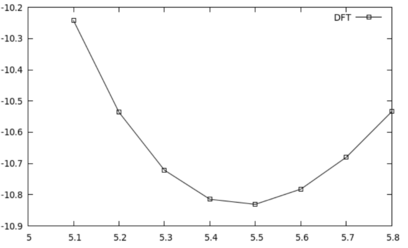Equilibrium volume of Si in the RPA
Overview > bandgap of Si in GW > bandstructure of Si in GW (VASP2WANNIER90) > bandstructure of SrVO3 in GW > CRPA of SrVO3 > Equilibrium volume of Si in the RPA > List of tutorials
Task
Calculation of the equilibrium lattice constant of Si in the RPA (ACFDT).
Input
POSCAR
system Si 5.8 0.5 0.5 0.0 0.0 0.5 0.5 0.5 0.0 0.5 2 cart 0.00 0.00 0.00 0.25 0.25 0.25
Calculation
The workflow of RPA total energy calculations consists of five consecutive steps:
- Step 1: a “standard” DFT groundstate calculation with a “dense” mesh of k-points.
- Step 2: compute the Hartree-Fock energy using the orbitals of Step 1. Needs WAVECAR file from step 1.
- Step 3: a “standard” DFT groundstate calculation with “coarse” mesh of k-points.
- Step 4: obtain DFT “virtual” orbitals (empty states). Needs WAVECAR file from step 3.
- Step 5: the RPA correlation energy (ACFDT) calculation. Needs WAVECAR and WAVEDER files from step 4.
In case of metallic systems there is an additional step between Steps 4 and 5, that is beyond the scope of this example.
All of the calculation steps are prepared in the script doall.sh.
Step 1: DFT groundstate calculation with a “dense” mesh of k-points
- The following INCAR file is used (INCAR.DFT):
ISMEAR = 0 ; SIGMA = 0.05 EDIFF = 1E-8
- The following KPOINTS file is used (KPOINTS.12):
12x12x12 0 G 12 12 12 0 0 0
Step 2: Compute the Hartree-Fock energy using the DFT orbitals
- To Compute the Hartree-Fock energy using DFT orbitals we need the (WAVECAR) of Step 1.
- The INCAR file INCAR.EXX is used in this step:
ALGO = EIGENVAL ; NELM = 1 LWAVE = .FALSE. LHFCALC = .TRUE. AEXX = 1.0 ; ALDAC = 0.0 ; AGGAC = 0.0 NKRED = 2 ISMEAR = 0 ; SIGMA = 0.05 KPAR = 8 NBANDS = 4
- NKRED=2 is used for the downsample the k-space representation of the Fock-potential to save time.
- Using NBANDS=4 only occupied states are considered to save time.
Step 3
- DFT groundstate calculation with a “coarse” mesh of k-points.
- The following INCAR file is used (INCAR.DFT):
ISMEAR = 0 ; SIGMA = 0.05 EDIFF = 1E-8
- The following coarse KPOINTS file is used (KPOINTS.12):
6x6x6 0 G 6 6 6 0 0 0
Step 4
- Obtain DFT "virtual" orbitals (empty states).
- The following INCAR file is used in this step (INCAR.DIAG):
ALGO = Exact NBANDS = 64 NELM = 1 LOPTICS = .TRUE. ISMEAR = 0 ; SIGMA = 0.05
- In this step one needs to set LOPTICS=.TRUE. to have VASP calculate the derivative of the orbitals w.r.t. the Bloch wavevector (stored in the WAVEDER file). These are needed to correctly describe the long-wavelength limit of the dielectric screening.
- We use exact diagonalization (ALGO=Exact) and keep 64 bands after diagonalization (NBANDS=64).
- This calculations needs the orbitals (WAVECAR file) written in Step 3.
Step 5
- The RPA correlation energy (ACFDT) calculation.
- The following INCAR file is used in this step (INCAR.ACFDT):
ALGO = ACFDT NBANDS = 64 ISMEAR = 0 ; SIGMA = 0.05
- In OUTCAR.ACFDT.X.X one finds the RPA correlation energy, e.g.:
cutoff energy smooth cutoff RPA correlation Hartree contr. to MP2
---------------------------------------------------------------------------------
163.563 130.851 -10.7869840331 -19.0268026572
155.775 124.620 -10.7813600055 -19.0200457142
148.357 118.685 -10.7744584182 -19.0118291822
141.292 113.034 -10.7659931963 -19.0017871991
134.564 107.651 -10.7555712745 -18.9894197881
128.156 102.525 -10.7428704760 -18.9742991317
122.054 97.643 -10.7273118140 -18.9556871679
116.241 92.993 -10.7085991597 -18.9331679971
linear regression
converged value -10.9079580568 -19.1711146204
- Take the “converged value”, in this case: EC(RPA) = -10.9079580568eV (an approximate “infinite basis set” limit).
- This calculations needs the orbitals (WAVECAR file) and the derivative of the orbitals w.r.t. the Bloch wavevectors (WAVEDER file) written in Step 4.
- The RPA total energy is calculated as the, E(RPA)=EC(RPA)+EXX sum of the RPA correlation energy of step 5 EC(RPA) and the Hartree fock energy EXX. To get the Hartree fock energy grep “free energy” in the OUTCAR.EXX.* file (there are two spaces between free and energy).
- The sample output for the total energy vs volume curves for DFT and RPA should look like the following:
Download
Overview > bandgap of Si in GW > bandstructure of Si in GW (VASP2WANNIER90) > bandstructure of SrVO3 in GW > CRPA of SrVO3 > Equilibrium volume of Si in the RPA > List of tutorials
Back to the main page.


